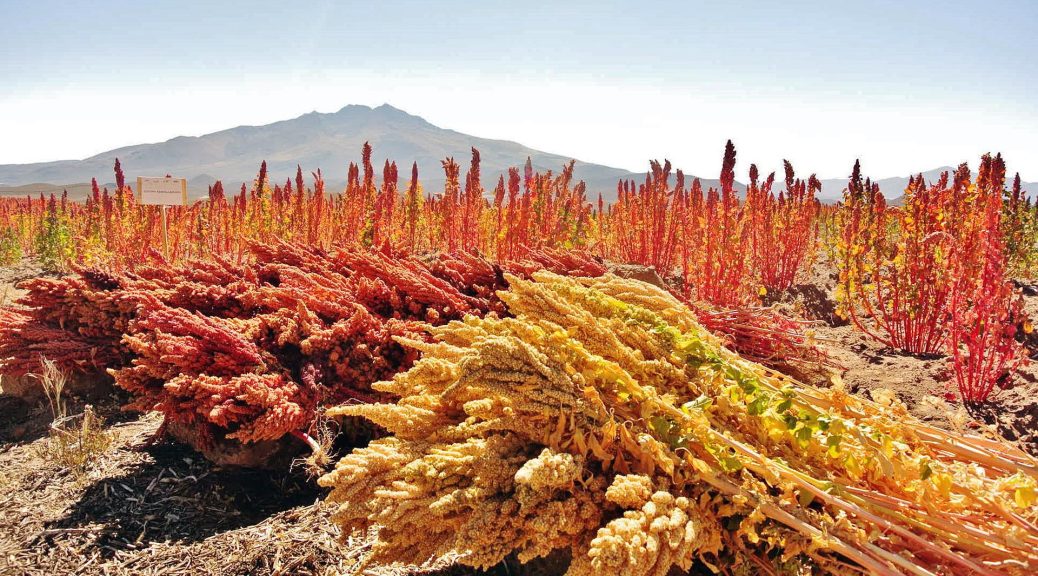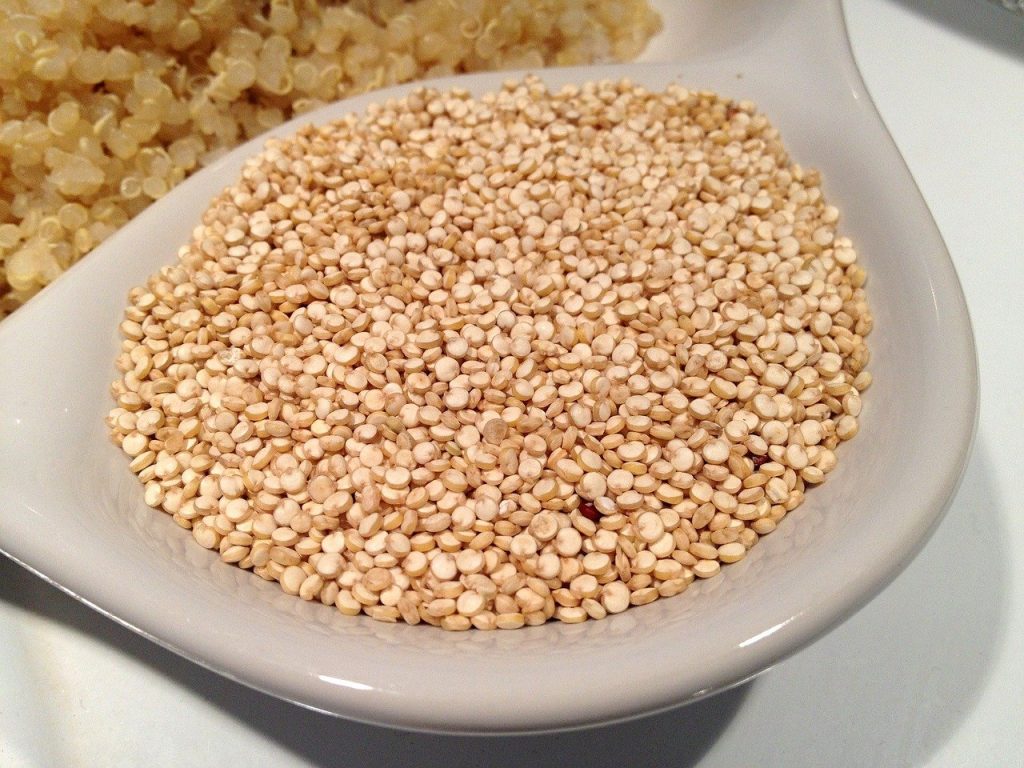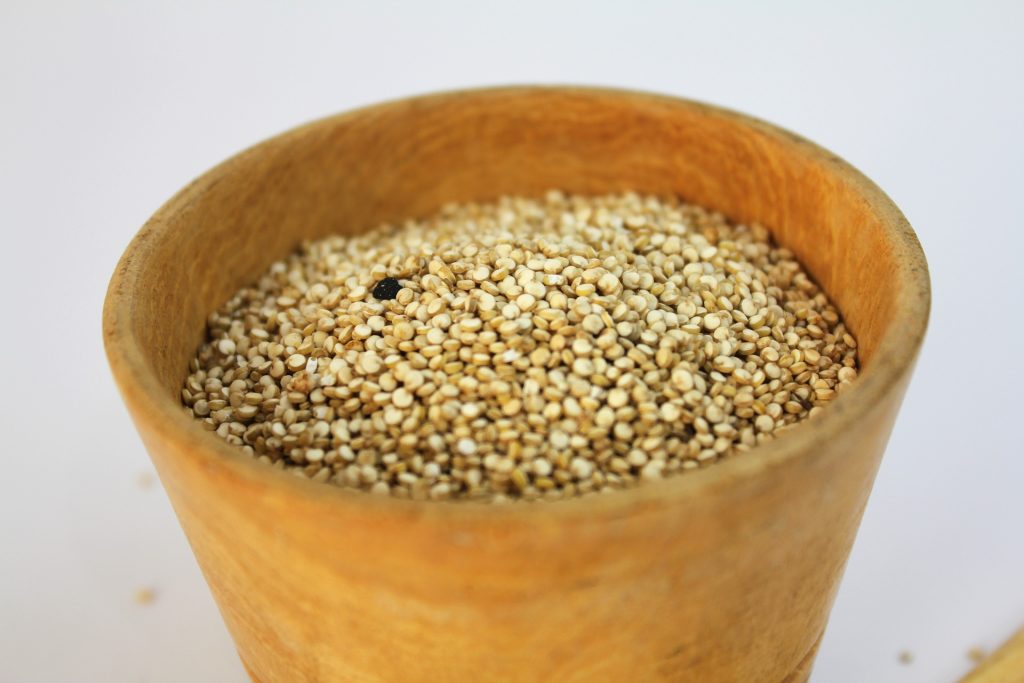
Quinoa and Amaranth
In this post, we’re going to talk about two grains native to the Andean highlands, located between Bolivia, Peru, and Ecuador, which have been the basis of the diet for these communities since ancient times. Both grains have been consumed by the Incas and earlier cultures (for about 7000 years), and they have gained popularity in Western countries in recent years. These grains are quinoa (Chenopodium quinoa) and amaranth (Amaranthus caudatus), also known as kiwicha in their countries of origin. Another grain known as kañiwa (Chenopodium pallidicaule) exists, but it is less known in the West, at least for now. All these grains belong to the amaranth family. These grains have been an important source of protein for indigenous communities, supplementing lower consumption of animal protein. Today, they have gained fame in Western cultures precisely because of their composition and nutritional advantages, but this point should be carefully evaluated. It’s also noteworthy that quinoa is much more widely known than amaranth, despite being very similar grains. This is because the United Nations declared 2013 as the International Year of Quinoa. Since then, its popularity has grown worldwide. Consequently, global production has significantly increased, shifting from local cultivation to production in nearby countries that were not producers before, or at least in areas where they were not previously produced. But they have also begun to be produced in North American and European countries, for example.
Advantages
Both grains are often categorized as pseudocereals, along with buckwheat. This is because their grain morphology resembles that of cereals, with an outer layer similar to bran, starchy endosperm, and a germ rich in fats, and they do not belong to any known group like legumes or oilseeds. However, it must be said that not everyone likes this pseudocereal classification, as it takes the spotlight away from the grain itself. Another important point is that since they are not cereals, they do not contain gluten and are therefore suitable for coeliacs and other intolerants or allergic individuals, provided they are processed with the necessary guarantees to avoid cross-contamination.
As we have mentioned, these grains have provided an important protein source for highland communities, and precisely because of this protein contribution, they have gained some fame in the West. As I always say, one must be very careful with nutritional composition tables, as sometimes white and wholemeal flours are compared without clarification. And usually, only average values are provided, or those of certain grains obtained for the study. But there is a wide variation among varieties, or depending on the soil-climatic conditions of cultivation, in many grains. For example, I have seen wheat with less than 9% protein and others with over 18%. The truth is that quinoa and amaranth have a slightly higher protein content than most cereals, especially gluten-free cereals like rice or corn. But their protein content is much lower than that of legumes. In general, we can say that the protein content of these grains is around 15%, while some gluten-free cereals do not reach 10-11%. But others like oats may have similar contents to these grains, as do some varieties of wheat. Therefore, we cannot say that the consumption of quinoa and amaranth will significantly increase our protein intake compared to that of other cereals, especially if it is occasional or incorporated in small percentages into some formulations. However, it is true that the amino acids in the proteins of these grains are better balanced, and therefore the nutritional quality of these proteins is higher. It is usually compared to that of dairy caseins. This will be important in vegan diets, where an incorrect diet may result in a lack of some essential amino acids. However, it is not common for diets that include milk, eggs, and meat products in developed countries to have such deficiencies. Also, in the case of vegan diets, it is possible to obtain a balanced protein intake by combining cereals with legumes, without resorting to other types of grains.
Some writings mention the advantages of the lipid content of these grains. Basically, their fats have a composition similar to that of cereals, such as corn, with a low content of saturated fatty acids. It is also true that when consumed many times in their whole form, the consumption of these lipids is higher than in the case of cereals, where the more fatty parts are usually separated beforehand, except for oats if not consumed in whole form. Similarly, the fibre and mineral content will be higher when consumed in whole form, but not very different from that of other whole grains.
And of course, these grains also contain certain antioxidant components, but they are much more abundant if the grain is whole and in darker varieties, which also tend to be more bitter. This also happens in most cereals. There are studies on possible nutritional advantages of these compounds, but usually in their isolated form, or in higher proportions than those that are usual in sporadic consumption of these products. Similarly, there are analogous studies in different cereals, although we are already used to them and do not give them as much importance.
But obviously, one of the advantages of these crops is their good nutritional image, regardless of whether it is based on real data.
Agronomically, these crops have the advantage of adapting to extreme conditions, as demonstrated by the fact that they are currently grown in many locations with different soil-climatic conditions.
Disadvantages
The main drawback of these grains is their higher cost, partly due to the lower yield of these crops, partly due to the lower supply. And we must also be careful with aspects such as carbon footprint, especially if they are imported from their countries of origin. Nowadays, there are already plantations in their countries of origin at sea level, with greater use of fertilizers and phytosanitary products, to obtain higher yields and greater crop safety, just as they are already grown in Europe and North America. For this, varieties that better adapt to these conditions and their subsequent transformation have been determined, which can influence the nutritional composition of the grains obtained. We must also consider that, due to the lower resistance of some of these varieties to certain conditions, or because of the interest in obtaining higher yields, they often use a greater number of fertilizers and pesticides. But despite advances in cultivation, their yield is lower than that of other cereals, the supply is lower, and therefore their cost is higher.
The second major issue is their saponin content. Saponins are substances present in the pericarp of quinoa that impart a strong bitterness, hence they must be removed before consumption. These saponins can reach up to 5% in certain quinoa varieties, but there are also saponin-free quinoa varieties (less than 0.11%) called sweet quinoa. Saponins have a high foaming power, similar to aquafaba from legumes, and act as emulsifiers. However, they also have a hemolytic effect on red blood cells and are toxic to cold-blooded animals.
Traditionally, methods both wet and dry have been used to remove saponins from quinoa. Wet methods involve soaking quinoa and rubbing it to allow the saponins to pass into the water. These methods have the drawback of high drying costs, generating wastewater with high saponin content that is difficult to utilise, and may induce grain germination, altering their functional characteristics. In fact, these grains readily germinate. Dry methods are simpler, involving abrasion treatment to remove the outer layers where saponins concentrate. However, this method often does not effectively remove saponins, and the more abrasive the treatment is, the greater the loss of nutrients from these layers, such as fibre or minerals. It’s also possible to combine both methods, subjecting them to a light wash after less severe abrasion. Due to the challenges posed by these treatments, saponin-free varieties are more popular in Western countries. However, these varieties are also less protected against bird and other animal attacks, as seen in the case of red sorghum versus white sorghum. This must be taken into account in plantations. It’s worth noting that amaranth does not present these saponin presence issues.
The final drawback of these grains and their flours is the flavour they impart to products. This flavour is neither good nor bad once saponins are removed in the case of quinoa, but it’s not a taste most people are accustomed to. Therefore, some may like it while others may not. In my experience, the majority of the population finds it more off-putting than appealing, but there are also consumers very favourable to these products. Generally, these unusual flavours are more noticeable in products with neutral flavours, such as bread, and they also tend to stand out in sweet products like cakes or biscuits, whereas they are less problematic when the grain is cooked with sauces or other dressings. We also have to consider that these grains are usually consumed in their whole form, and the taste of whole products, or those made from whole grain flours, is also not to everyone’s liking.
Inclusion in baked goods
Once saponins, if necessary, have been removed, the grains need to be milled. Milling opens up multiple possibilities. Progressive milling can be done using roller mills, similar to those used for wheat milling, although less common. Alternatively, after removing all impurities, grains can be milled using hammer mills or other types. These milling methods can be more aggressive to obtain finer flours, or less so. They can also attempt to reduce the content of outer layers (through sieving) or leave them intact to obtain whole flours. It should be noted that generally quinoa and amaranth flours tend to be whole flours, as removing the bran would greatly reduce yields and their nutritional quality. Moreover, consumers most receptive to these grains also tend to prefer whole flours. The milling system will affect damaged starch content, particle size of the flours, and their composition (depending on whether outer layers are more or less removed). These grains are slightly harder than wheat, which combined with the fact that they are usually marketed in their whole form, means that quinoa and amaranth flours tend to be somewhat coarser than wheat flours.
It’s also important to consider that higher lipid content can reduce the shelf life of these flours, due to rancidity problems. However, unlike some cereals, no lipoxygenase activity has been observed in desaponified quinoa, so there’s no need to apply a heat treatment to inactivate these enzymes. Nevertheless, the presence of a higher amount of lipids always somewhat reduces shelf life. Although not necessary, in some cases grains may undergo some type of heat pre-treatment, which can alter the functionality of the flours. These treatments can also positively alter the flavour and aroma of these flours. Thus, there’s significant trade in flakes or extruded products made from quinoa or amaranth flours. And to obtain these products, grains or their flours undergo heat treatments.
In the case of bread and products where gluten network formation is necessary, the inclusion of quinoa and amaranth flours will dilute this network, hence they cannot be incorporated in higher percentages than 10-20%. Otherwise, it will result in stickier doughs, difficult to handle, with reduced gas retention capacity during fermentation and baking. Even in those cases, to avoid issues, it will be necessary to use flours with higher strength, incorporate gluten, or use reinforcing additives. The influence on the final flavour also typically discourages a higher percentage. In these cases, the potential nutritional advantages of using these types of flours will be greatly diminished, especially if consumption of such products is occasional.
For products like cakes or cookies, the inclusion of these flours is easier, as the gluten network is not necessary, and the unusual flavours are usually partially masked. In fact, cookies can be made with 100% of these types of flours. However, in these cases, we must consider very important aspects, such as particle size, especially crucial for cakes, and the water absorption capacity of the flours, which greatly influences the rheology of cookie doughs. If these flours are mixed in small proportions with others like wheat, these aspects won’t be as crucial. But as the percentage of these flours increases, and therefore their influence on the characteristics of the doughs and the final product, it will be necessary for these flour properties to be consistent, as well as colour and aroma. And, as we have seen, varieties, growing conditions, preprocessing, and obviously milling systems, can alter these characteristics. Although it’s possible to increase the percentage of these flours in these products, the influence of these on the final flavour must always be considered. And the nutritional advantages won’t make as much sense, as we’re talking about products with a high sugar and fat content. In reality, the percentages of quinoa or amaranth flour in these products also usually don’t exceed 20%.
The case of gluten-free bread can be one of the most attractive for the inclusion of these types of flours, as these usually have a lower protein content than wheat bread. And a lower nutritional quality, something that quinoa and amaranth flours could partially overcome. However, the use of starches, such as corn or wheat, greatly improves the volume of these products and it’s difficult to replace them with flours. On the other hand, a high use of quinoa and amaranth flours will strongly influence the aroma and flavour, not being appreciated by all consumers. And the final product cost will rise. Therefore, the use of these flours in gluten-free breads is usually reserved for some very special breads for a very specific type of consumer, or for use in small doses, playing with the final flavours, and with the positive marketing that these additions present.
In summary,
Amaranth and quinoa are interesting grains that expand the range of these types of products. Overall, they have a good nutritional image, especially quinoa, which can make them attractive for incorporation into baked goods or some diets. However, in general, the differences with other grains are not exaggerated, and their occasional consumption should not significantly modify our health, neither for the better nor for the worse.
Additionally, in the case of quinoa, it’s necessary to consider the required removal of saponins, in the case of varieties that contain them. And both varieties, growing conditions, and preprocessing and milling treatments can affect both the composition and functional properties of the obtained flours. Therefore, if these flours have a significant role in formulations, it will be necessary to obtain flours with homogeneous properties if we want to obtain regular final products. In this case, it will be advisable to standardise aspects such as protein content, particle size, or water absorption capacity.
For these reasons, in addition to their high price and sensory implications, the inclusion of amaranth and quinoa flours is usually minority in the products they’re incorporated into, at least in Western countries, where consumers are not accustomed to these grains.
I’ll leave you with an image of quinoa and another of amaranth, as you’ll see, they are very similar in shape and size.

Sweet Quinoa

Amaranth
For further information
Aderibigbe, OR; Ezekiel, OO; Owolade, SO; Korese, JK; Sturm, B; Hensel, O (2022) Exploring the potentials of underutilized grain amaranth (Amaranthus spp.) along the value chain for food and nutrition security: A review. Critical Reviews in Food Science and Nutrition, 62, 656-669.
Coelho, LM; Silva, PM; Martins, JT; Pinheiro, AC; Vicente, AA (2018) Emerging opportunities in exploring the nutritional/functional value of amaranth. Food & Function, 9, 5499-5512.
Graf, BL; Rojas-Silva, P; Rojo, LE; Delatorre-Herrera, J; Baldeon, ME; Raskin, I (2015) Innovations in health value and functional food development of quinoa (Chenopodium quinoa Willd.). Comprehensive Reviews in Food Science and Food Safety, 14, 431-445.
Navruz-Varli, S; Sanlier, N (2016) Nutritional and health benefits of quinoa (Chenopodium quinoa Willd.). Journal of Cereal Science, 69, 371-376.
Repo-Carrasco, R; Espinoza, C; Jacobsen, SE (2003) Nutritional Value and Use of the Andean Crops Quinoa (Chenopodium quinoa) and Kañiwa (Chenopodium pallidicaule). Food Reviews International, 19, 179–189.
Simnadis, TG; Tapsell, LC; Beck, EJ (2015) Physiological effects associated with quinoa consumption and implications for research involving humans: a review. Plant Foods for Human Nutrition, 70, 238-249.
Vega-Galvez, A; Miranda, M; Vergara, J; Uribe, E; Puente, L; Martinez, EA (2010) Nutrition facts and functional potential of quinoa (Chenopodium quinoa willd.), an ancient Andean grain: a review. Journal of the Science of Food and Agriculture, 90, 2541-2547.
Wang, SN; Zhu, F (2016) Formulation and quality attributes of quinoa food products. Food and Bioprocess Technology, 9, 49-68.